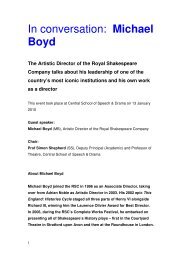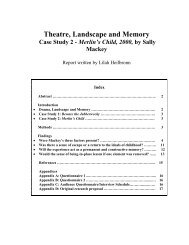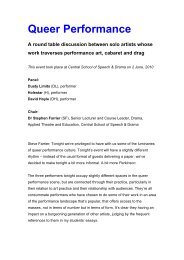- Page 1 and 2: THE RISE OF MANIPULACTINGTHE PUPPET
- Page 3: ACKNOWLEDGEMENTSThis research has b
- Page 7 and 8: TABLE OF CONTENTSNotes for the read
- Page 9 and 10: 4.3. Conclusion 166Chapter V The Ma
- Page 11 and 12: List of figuresFigure 4.1 Tranter a
- Page 13 and 14: NOTES FOR THE READERSThe mainspring
- Page 15 and 16: staging issues such as characters w
- Page 17 and 18: particular form of performance but
- Page 19 and 20: performer and the puppet. The start
- Page 21 and 22: productions looking at this relatio
- Page 23 and 24: already present in the two first ve
- Page 25 and 26: • Who is the Other represented by
- Page 27 and 28: 2) Member of a proposition about wh
- Page 29 and 30: Adrian Mirvish and Adrian van den H
- Page 31 and 32: accept the determination of structu
- Page 33 and 34: organisation without distance of th
- Page 35 and 36: specific effects of alterity. In Ch
- Page 37 and 38: company Morbus Théâtre. One of th
- Page 39 and 40: Sergei Obraztsov, who embraced Mode
- Page 41 and 42: organisations decided to explore ne
- Page 43 and 44: However, unlike their fellows from
- Page 45 and 46: time of writing this thesis. The di
- Page 47 and 48: inspired by other contemporary arti
- Page 49 and 50: performances. 3 It is by default or
- Page 51 and 52: [Albrecht Roser] trained me in stri
- Page 53 and 54: Another level of interaction consis
- Page 55 and 56:
makes it difficult to provide a gen
- Page 57 and 58:
elation between the body of the cha
- Page 59 and 60:
presence exist in manipulacting. Th
- Page 61 and 62:
forcing Tamar to pray alongside him
- Page 63 and 64:
perform in venues traditionally ded
- Page 65 and 66:
which the presence of the puppet is
- Page 67 and 68:
manipulactor to give the impression
- Page 69 and 70:
CHAPTER IIIA PHENOMENOLOGICAL PERSP
- Page 71 and 72:
weight and tension which can be fru
- Page 73 and 74:
ground and her movements were large
- Page 75 and 76:
3.1.2. PostalgiaPostalgia is a twen
- Page 77 and 78:
ecomes a prisoner. Alongside this r
- Page 79 and 80:
ut there is no direct interaction b
- Page 81 and 82:
through movements that are read on
- Page 83 and 84:
presence of the performer. Yet, suc
- Page 85 and 86:
production. It had the longest rese
- Page 87 and 88:
their gazes. Although this is partl
- Page 89 and 90:
different levels of performance, an
- Page 91 and 92:
een integrated into the dramaturgy
- Page 93 and 94:
dialogue. Understanding how the alt
- Page 95 and 96:
alienation insofar as it engages co
- Page 97 and 98:
down on a small table while Nakamur
- Page 99 and 100:
However, Sartre disagrees with Hege
- Page 101 and 102:
106). The inter-subjective awarenes
- Page 103 and 104:
etween imagination and perception i
- Page 105 and 106:
Sartre first admits that the impers
- Page 107 and 108:
analogous to that which can appear
- Page 109 and 110:
interactions between Okoto and Naka
- Page 111 and 112:
the impression of an apparent subje
- Page 113 and 114:
internal negation is a relation bet
- Page 115 and 116:
Pierre as imaged. Conversely, unrea
- Page 117 and 118:
As Sartre and Levinas contend, a re
- Page 119 and 120:
CHAPTER IVCASE STUDIESTWO REPRESENT
- Page 121 and 122:
University to become a teacher, he
- Page 123 and 124:
theatre’ as ‘dramatic theatre i
- Page 125 and 126:
elated: a particular design affects
- Page 127 and 128:
head and occasionally the arms. The
- Page 129 and 130:
audience’s point of view. The mov
- Page 131 and 132:
triangulation taking place between
- Page 133 and 134:
positioned on one side of her, leav
- Page 135 and 136:
expression ‘more likely’ becaus
- Page 137 and 138:
Figure 3.7 Tranter and Muttirubbing
- Page 139 and 140:
about Lupus’ remark. By looking i
- Page 141 and 142:
Tranter to build a relation of self
- Page 143 and 144:
his directorial work as well as the
- Page 145 and 146:
Twin Houses consists of a series of
- Page 147 and 148:
this quality should be applied to t
- Page 149 and 150:
although it is not very clear wheth
- Page 151 and 152:
The Double has a more complete repr
- Page 153 and 154:
Double and sometimes the Man. This
- Page 155 and 156:
All of a sudden he takes her head i
- Page 157 and 158:
hand in order to diffuse all the mo
- Page 159 and 160:
never acknowledges the presence of
- Page 161 and 162:
heads are covered with veils which
- Page 163 and 164:
elationship set between puppets and
- Page 165 and 166:
thinking about something. At the sa
- Page 167 and 168:
linked to the self. The irreal body
- Page 169 and 170:
separates from these Others when he
- Page 171 and 172:
CHAPTER VTHE MAIDSONTOLOGY, DRAMATU
- Page 173 and 174:
original setting established by Gen
- Page 175 and 176:
of his shows during my research res
- Page 177 and 178:
Apart from the head, the design of
- Page 179 and 180:
subjectness. Thus, it appeared nece
- Page 181 and 182:
Maids2, Claire suspends the alterit
- Page 183 and 184:
manipulacting because the productio
- Page 185 and 186:
of emotion it is usually translated
- Page 187 and 188:
also forced the performers to remai
- Page 189 and 190:
the energy and warmth coming from A
- Page 191 and 192:
choices of relationship that were t
- Page 193 and 194:
Nakamura with Ilka Schönbein at th
- Page 195 and 196:
strongly characterised in this firs
- Page 197 and 198:
on the telling of the story than on
- Page 199 and 200:
The audience could not see the conn
- Page 201 and 202:
the previous section. Live shadows
- Page 203 and 204:
weight. In order to move the puppet
- Page 205 and 206:
Urashima Taro’s love. On one hand
- Page 207 and 208:
UT3 is intended to go one step furt
- Page 209 and 210:
consciousness is only directed towa
- Page 211 and 212:
One cannot help thinking that Otohi
- Page 213 and 214:
do not perceive her but instead enc
- Page 215 and 216:
CHAPTER VIIA METHOD OF PRACTICE FOR
- Page 217 and 218:
approach is through movement, it is
- Page 219 and 220:
gravity has to be understood in the
- Page 221 and 222:
using body-parts isolation which al
- Page 223 and 224:
Five possible calibrations of the g
- Page 225 and 226:
puppet without an articulated mouth
- Page 227 and 228:
Finally, as discussed in Chapter V
- Page 229 and 230:
CHAPTER VIIICONCLUSIONThe purpose o
- Page 231 and 232:
elationship. Sylvie Baillon, artist
- Page 233 and 234:
Compagnie Mossoux-Bonté (2009) Sep
- Page 235 and 236:
Keene, D. (1973) Bunraku: The Art o
- Page 237 and 238:
Podehl, E. (1991) ‘Ceux Qui Touch
- Page 239 and 240:
Tranter, N. (2009) Interview discus
- Page 241 and 242:
APPENDIX AINTERVIEWSNicole MossouxN
- Page 243 and 244:
NM: Ce n’est pas si systématique
- Page 245 and 246:
PP: Est-ce que vous avez un autre r
- Page 247 and 248:
PP: Pour vous c’est comme si vous
- Page 249 and 250:
PP: Qu’est-ce que vous appelez ex
- Page 251 and 252:
PP: That came later somehow?NT: I c
- Page 253 and 254:
the puppet and starts to animate th
- Page 255 and 256:
INTERVIEW WITH DUDA PAIVAANDEDERSON
- Page 257 and 258:
PP: It’s very Stanislavskian.DP:
- Page 259 and 260:
PP: There is also a pleasure to kno
- Page 261 and 262:
PP: Is it when you are very close t
- Page 263 and 264:
you are very important because you
- Page 265 and 266:
KK: Having seen many puppet shows a
- Page 267 and 268:
Postalgia (19mn)Filmed by Monika Ki
- Page 269 and 270:
Urashima TaroUT1.1 (11mn)Filmed at
- Page 271 and 272:
Cuniculus (2008)Stuffed Puppet Thea






